How to
Build a Thermonuclear (Hydrogen) Bomb
|
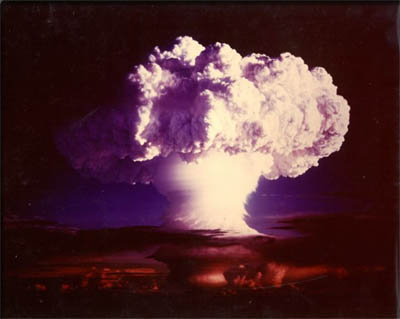
The
first thermonuclear device ever detonated: Mike Ivy in
1952.
|
By the
end of WWII, it was possible to build atomic bombs using fission
(the splitting of atoms) that could create explosions equal
to several hundred tons of TNT. Scientists suspected, however,
that even more powerful weapons could be built by forcing atoms
together, an effect called fusion. The United States tested
the first of these mega-weapons in 1952 with a blast equal to
10.4 million tons of TNT. How are these thermonuclear super
bombs built?
Almost
all the energy we come into contact with on Earth is the result
of chemical reactions. As a tree grows, it takes energy from
the sun and uses it to separate the carbon atoms from the oxygen
atoms in the carbon-dioxide in our air. The carbon it uses to
make its trunk and branches and it sets the oxygen free. When
we burn those branches, we reverse the process and let the oxygen
in the air combine with the carbon, returning the energy from
the sun in the form of light and heat from the fire. These are
examples of chemical reactions.
Fission
vs. Fusion
Nuclear
weapons, however, produce energy from the splitting apart (fission)
and combining of atoms (fusion). Nuclear reactions can be at
least a million times more powerful than chemical reactions.
The easier of these two nuclear reactions to use is fission
. This was used to make the first atomic bombs (For more information
on fission and atomic bombs see our article on "How
to Build an Atomic Bomb").
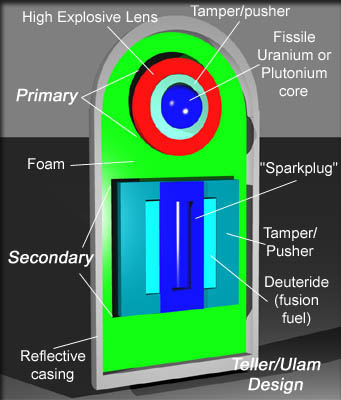 |
Forcing
atoms together as a way of releasing energy is called fusion.
It's the source of power for the stars, including our sun. Stars
are mostly balls of hydrogen gas, the simplest of all elements
(the atoms are composed of just one proton and one electron
and sometimes some neutrons). Normally atoms do not like to
fuse, but under the enormous pressures and temperatures inside
a star, it happens. Typically the nuclei (the centers) of six
hydrogen atoms will go through a series of reactions and emerge
as two helium atoms, two hydrogen atoms, a couple of positrons
(electrons with a positive charge) and, most significantly,
energy in the form of gamma rays.
When
scientists first thought about releasing energy by fusing hydrogen
atoms they had a real problem: There was no way on Earth to
generate the heat and pressures necessary to cause the hydrogen
to fuse. With the invention of the atomic bomb, however, they
realized that they now had a device that could produce those
energies. For this reason, every fusion bomb uses a fission
bomb as its trigger.
Almost
all thermonuclear bombs are multi-stage weapons. This means
that the energy from the earlier stages are used to trigger
the later stages. The first stage in such a bomb is a conventional
fission device: essentially a ball of uranium-235 or plutonium-239
surrounded by high explosives. Upon detonation, the explosives
compress the uranium or plutonium until a supercritical reaction
(the splitting of atoms that releases high energy neutrons that
split even more atoms) takes place, liberating energy in the
form of gamma rays along with a flood of high energy neutrons.
The
energy from this first stage would then be used to squeeze and
heat the hydrogen in the second stage until the point where
the atoms will fuse together to form helium and release energy.
Exactly how to direct the energy from the first stage to the
second stage was probably the most difficult problem in designing
this type of bomb, however.
Teller-Ulam
Design
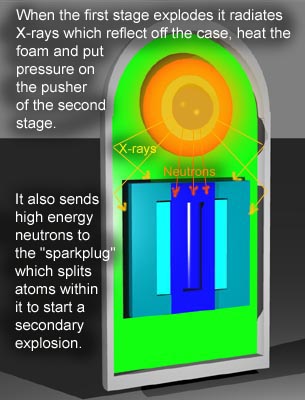 |
In 1951
physicists Edward Teller and Stanislaw Ulam came up with a scheme
that is now used in almost all multi-stage nuclear weapons.
In their design the second stage, shaped like a cylinder (in
some later designs the second stage was shaped like a sphere,
but does the same job), sits next to the first stage. The cylinder
consists of a pusher/tamper on the outside (often made of some
heavy metal such as lead or depleted uranium), the hydrogen
fuel on the inside and a "sparkplug" at the very center. The
rest of the interior of the bomb was filled with a secret material
that was a plastic similar to Styrofoam. As the gamma rays from
the first stage hit the plastic, it turns into a very hot plasma
which, in turn, starts to heats the out layers of the pusher/tamper
in the second stage. In addition, x-rays from the primary stage
reflect off the outer case of the bomb and are absorbed by the
tamper/pusher, further increasing its temperature. As the outer
layers of the tamper/pusher heat up, they vaporize, turn to
hot gas and the gas expands rapidly, putting huge amounts of
pressure on the remaining parts of the pusher/tamper. As the
pusher/tamper is compressed, it puts pressure on the hydrogen
fuel (which is why it's called the "pusher").
At the
same time the first stage fission is radiating huge amounts
of high energy neutrons. These are focused by a part of the
bomb called the "Neutron Focus Lens" onto the second stage.
The "spark plug" at the center of the second stage is made of
fissionable material (either uranium-235 or plutonium-239) and
as these high energy neutrons enter it, atoms hit by those neutrons
start to split in the "spark plug," releasing energy. The sparkplug
is, at the same time, being compressed by the hydrogen fuel.
The compression also aids in the fission of the sparkplug which
explodes and starts to push outward.
The
hydrogen fuel is then caught between the pusher, pressing in
on it and the spark plug pressing out. This puts the fuel under
enough pressure and heat for the hydrogen atoms to start to
fuse, release energy and the second stage explodes.
One
of the functions of the "pusher/tamper" is not just to push
inward on the hydrogen fuel, but to resist its outward motion
as it starts to explode (which is why it is also called a "tamper").
The longer the hydrogen is kept compressed, the more fusion
takes place, making the bomb more powerful.
Deuterium-Tritium
Fuel
One
of the problems that beset the designers of the bomb was the
fusion fuel. While stars use the fusion reaction described above,
scientists realized it would be more practical in a bomb to
use a form of a fusion reaction that would fuse deuterium (a
hydrogen atom with one neutron) with tritium (a hydrogen atom
with two neutrons). This reaction, in addition to producing
a helium atom and some gamma rays, also produced a free, high
energy neutron.
The
problem with this idea was that tritium is a radioactive form
of hydrogen that decays with time. Constantly replacing the
tritium in the second stage of the bomb would be difficult if
you had a large arsenal of weapons. What designers came to realize,
however, is that if they used lithium-deuteride as the fuel,
it would be turned into tritium and deuterium when it was bombarded
by free neutrons coming from the 1st stage of the weapon. This
method of creating the fuel as the bomb was actually detonating
greatly reduced the maintenance considerations of long-term
storage.
While
the above describes the basic functions of a thermo-nuclear
device, almost all of these bombs also include certain additional
features that increase the yield of the weapon.
Boosting
a Bomb
|
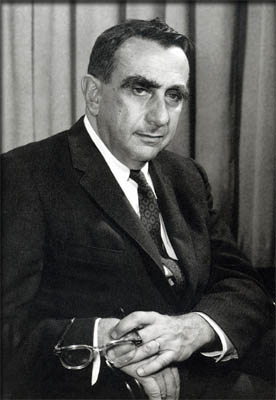
Edward
Teller with Stanislaw Ulam came up with a workable design
for the first hydrogen bomb.
|
One
of these features is a mechanism that "boosts" the power of
the bomb by injecting a small amount of deuterium/tritium gas
into the center of the 1st stage of the bomb shortly before
detonation. As the first stage explodes, the gas is compressed
until some of the hydrogen atoms fuse. This fusion adds to the
power of the bomb directly, but more importantly, it also releases
high energy neutrons which then radiate out to split additional
atoms in the first stage's uranium-235 or plutonium-239 primary
fuel. Boosting can double the power of the first stage without
adding additional, rare fissile material. Single stage atomic
bombs can also use this mechanism.
Output
can also be increased in the second stage by replacing the lead
in the pusher/tamper with uranium-238. Uranium-238 is not usually
considered "fissile" material because it does not produce the
high energy neutrons needed to split atoms. However, when uranium-238
is put next to the fusion fuel, its atoms can be split by the
high energy neutrons coming from the fusion reaction. In fact,
this mechanism is so effective it can double the power of the
bomb without adding any more rare fissile material.
Neutron
Bomb
Because
they are so efficient at increasing the power of the bomb, first
stage boosting and using uranium for the pusher/tamper are standard
for almost all thermonuclear devices. The one major exception
is the so called neutron bomb. In the 80's and 90's the American
planners were concerned about the large number of tanks in the
Warsaw Pact nations' military that might be used to invade NATO
countries. Soldiers in those tanks were relatively well protected
from nuclear blasts, so designers sought to minimize the blast
and long term fallout from the bomb while increasing the high-energy
free neutrons. Since these neutrons can readily penetrate tank
armor, such a bomb could incapacitate the tank crew while doing
fairly little damage to the defending nation's land and infrastructure.
One of the keys to making the neutron bomb work was to use a
lead pusher/tamper which reduced the blast effect without reducing
the output of high energy neutrons.
Three
Stage Bombs
Though
in theory it is possible to build weapons with an almost unlimited
number of stages (and therefore with unlimited power), the largest
bombs ever built only had three stages (an example is the so-called
"Tsar Bombe," a Russian device that could produce a 100-megaton
blast, but was only ever tested at 50 megatons). In reality,
there is little military necessity to build gigantic bombs with
more than two stages. In general, it is more effective to use
a number of smaller bombs to complete an objective, rather than
one big one.
|
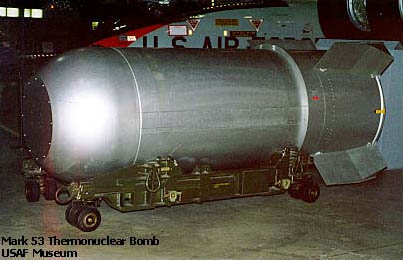
The
casing of a Mark 53 thermonuclear bomb at the USAF Museum.
|
Fortunately,
thermonuclear weapons are difficult to make and only a few nations
have mastered this skill. It isn't that the design is so complicated,
but the uranium-235 or plutonium-239 needed to build the first
stage is rare, difficult to produce and very closely guarded.
It is also why nuclear proliferation of these materials is such
a concern throughout the world.

Copyright Lee Krystek 2016. All Rights Reserved.